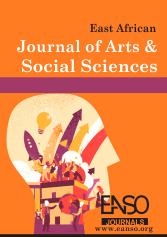Push and Pull Factors for Rural Migration to Squatter Settlements in Mwanza City, Tanzania
Abstract
This paper examines push and pull factors for rural migration to squatter settlements in Mwanza City, Tanzania. A mixed research approach and case study strategy were employed. Respondents included local government leaders and residents. Several sampling procedures were used to get respondents. Interviews, questionnaires, focus group discussions and observation yielded primary data, while documentary review provided secondary data. Qualitative data were subjected to content analysis and quantitative data were analyzed statistically. More females than males migrated to Mwanza City squatter areas and more youth migrated and settled there than other older age groups. Respondents had varied education levels with a higher illiteracy level among female than male respondents. Several pull factors accounted for people migrating from rural areas to Mwanza City in squatter settlements. Gender-based violence (GBV) as push factors included wife beating and discrimination by husbands and adolescent girls’ genital mutilation. Like elsewhere in the country, the government plans to deal with squatter settlements in Mwanza City. Some recommendations encompass the following: the government should institute policy and review the legal framework for good habitation in urban areas and weed out Gender-Based Violence, chiefly for women and adolescent girls; and it should further control and prevent sprawl plus dynamics of squatter settlements
Downloads
References
Arimah, B. C. (2010). The face of urban poverty: Explaining the prevalence of slums in developing countries (No. 2010/30). WIDER working paper.
Babbie, E. R. (2020). The practice of social research. Cengage Au.
Council, M. C. (2008). Mwanza City Profile. Mwanza: Mwanza Ciuty Council.
Cochran, J. (1977). Sampling Techniques. New York: Macmillan Publishing Company.
Cohen, L., Manion, L., & Morrison, K. (2002). Research methods in education. Routledge.
Cohen, L., Manion, L. and Morrison, K. 2000. Research Methods in Education. 5th ed. London: Routledge Falmer
Deshingkar, P., & Grimm, S. (2005). Internal migration and development: A global perspective. United Nations.
Faru, S. (2019). Assessment of Prevention and Control of Squatters in Mwanza City, Tanzania through Social Responsibility Approach.
Gibson, M. A., & Gurmu, E. (2012). Rural to urban migration is an unforeseen impact of development intervention in Ethiopia. PLoS One, 7(11), e48708.
Guria, N., & Tiwari, V. K. (2013). Migration and living conditions in urban slums: a case study of Bilaspur city (Chhattisgarh). Journal of Research Strategy, Kanpur, UP, 1-18.
Ishtiaque, A., & Ullah, M. S. (2013). The influence of factors of migration on the migration status of rural-urban migrants in Dhaka, Bangladesh. Human Geographies, 7(2), 45.
Kironde, J. L. (1995). Access to land by the urban poor in Tanzania: some findings from Dar es Salaam. Environment and Urbanization, 7(1), 77-96.
Komba, M. P. (2008). “Rigid Planning Standards and Procedures: Planning for Development of Spontaneous Settlements in Tanzania: A Case of Mabatini, Mwanza.” Ardhi and Settlement Development Organization (ARISEDO) Report.
Lee, E. (/1966). “A Theory of Migration,” Demography, Vol. 2, No 1: 47-57.
Limbumba, T. M. (2010). Exploring social-cultural explanations for residential location choices: The case of an African city - Dar es Salaam (Doctoral dissertation, KTH).
Mabogunje, A. (1970). “System Approach Theory of Rural-Urban Migration.” Geographical Analysis 2(1): 1-18.
Manotham, P. (2010). Bangkok Urban Dynamics and Housing Market. Stockholm Royal Institute of Technology.
Manjunatha, S., & Anilkumar, B. K. (2012). Urbanization and its impacts on the Sub-Urbs of Bangalore City. International Journal of Current Research and Review, 4(21).
Mhache, E. P. and Mauma, M. (2013) Dar es Salaam City Crisis: The Result of Rapid Urbanization. Dar es Salaam: AERA Kiswahili Researched Products.
Mwanza City Council (2014). Mwanza City Profile. Mwanza: Mwanza City Council
Khalifa, M. A. (2011). Redefining slums in Egypt: Unplanned versus unsafe areas. Habitat International, 35(1), 40-49.
McGee, T. (1991). The Emergence of Desakota Regions in Asia: Expanding a Hypothesis. Hawaii: University of Hawaii Press.
Supply, M. U. W., Authority, S., & Zone, N. L. (2018). LVWATSAN–Mwanza Environmental and Social Impact Assessment Report for Water Supply and Wastewater Short-Term Investment Plan for Mwanza City–Tanzania.
National Bureau of Statistics [(NBS) 2012]. Population Census. Dar es Salaam: Government Printer.
National Bureau of Statistics (NBS). (2002). National census report. Government Printer, Dar es Salaam.
Nyang’oro, J. E. (2004). Ethnic structure, inequality and governance of the public sector in Tanzania. United Nations Research Institute for Social Development Working Paper.
Okhankhuele, O. T., & Opafunso, O. Z. (2013). Causes and consequences of rural-urban migration Nigeria: A case study of Ogun Waterside Local Government area of Ogun State, Nigeria. British Journal of Arts and Social Sciences, 16(1), 185-194.
Onyekachi, A. F. (2014). Prospects and challenges of informal settlements and urban upgrading in Abuja. International Journal of Innovation and Scientific Research, 11(2), 420-426.
Şenyapılı, Tansı. "Charting the ‘voyage’of squatter housing in urban spatial ‘quadruped’." European Journal of Turkish Studies. Social Sciences on Contemporary Turkey 1 (2004).
Rodgers, D., Beall, J., & Kanbur, R. (2017). Latin American Urban Development into the 21st Century: Towards A Renewed Perspective on the City.
Todaro, M. P. (1969). A model of labor migration and urban unemployment in less developed countries. The American Economic Review, 59(1), 138-148.
United Republic of Tanzania (2016). MWANZA REGION SOCIO-ECONOMIC PROFILE, 2016. Dar es Salaam: Ministry of Finance, National Bureau of Statistics and Mwanza Regional Secretariat.
United Republic of Tanzania, (2013). Population and Housing Census: Population Distribution by Administrative Areas. National Bureau of Statistics, Ministry of Finance, Dar es Salaam and Office of Chief Government Statistician, President’s Office, Finance, Economy and Development Planning, Zanzibar.
UN-HABITAT, (2009). National Urban Profile Tanzania. Nairobi: UNON.
UN-HABITAT, (2007). Enhancing Urban Safety and Security: Global Report on Human Settlements 2007. London: Earthscan Publications Limited.
UN-HABITAT, (2003). The Challenge of Slums: Global Report on Human Settlements 2003. London: Earthscan Publications Limited.
UN-HABITAT, (1996). An Urbanizing World: Global Report on Human Settlements, 1996. London: Oxford University Press.
Copyright (c) 2025 Sakina Faru

This work is licensed under a Creative Commons Attribution 4.0 International License.




























